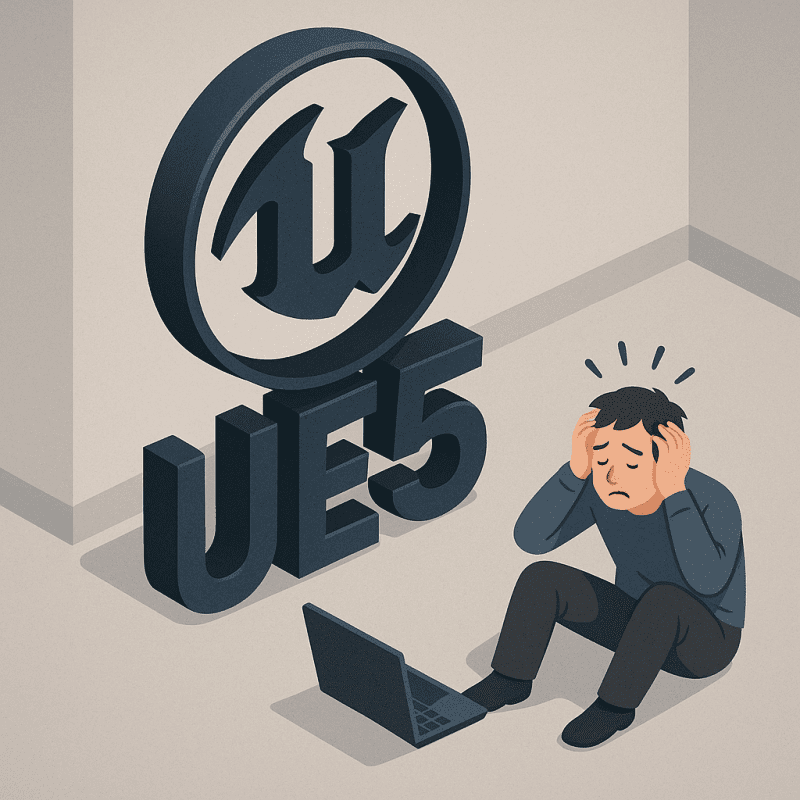Table of Contents Show
When Unreal Engine 5 (UE5) officially dropped, it felt like a revolution. Demos like The Matrix Awakens blew everyone’s minds. Developers, gamers, and industry professionals agreed: UE5 looked amazing. It promised limitless photorealism, smoother pipelines, and even “easier” game creation for smaller studios.
But fast-forward to today, and a different conversation is happening. While Unreal Engine 5 is incredible, it’s not flawless. In fact, depending on who you ask, it’s either an exciting next step or a nightmare wrapped in gorgeous lighting effects.
Today, let’s cut through the marketing buzz. Let’s talk honestly about what’s wrong with Unreal Engine 5.
Performance Demands Are Brutal
Unreal Engine 5’s headline features like Nanite and Lumen sound (and look) amazing. Nanite allows near-infinite geometric detail. Lumen provides fully dynamic global illumination. But the price you pay? Performance.
If you’re not running a high-end PC or a top-spec next-gen console, you’re going to feel it. Even developers with powerful rigs are struggling to maintain consistent frame rates when building UE5 games. That’s one reason why many studios still use Unreal Engine 4 under the hood, even when they say they’re using “Unreal 5.”
| Issue | Effect |
|---|---|
| Nanite | Requires careful asset management to avoid memory bloat |
| Lumen | Can cause major frame rate drops if not tweaked perfectly |
Epic promised scalability, but the reality is, unless you’re spending serious time optimizing, UE5 projects can quickly become unplayable for most gamers.
File Sizes Are Outrageous
Nanite’s incredible detail means games built in UE5 are huge. Massive. Games like Fortnite (which now uses UE5) have ballooned in size – and that’s even after aggressive optimization.
Bigger textures, denser geometry, and full dynamic lighting all add up. Developers are being forced to make tough decisions: Do they keep that mind-blowing visual fidelity and force players to download 200+ GB games? Or do they sacrifice some detail to make downloads manageable?
This is especially painful for indie developers. Small teams don’t have giant server farms to host 300 GB downloads.
Not Truly Indie-Friendly (Yet)
Speaking of indie developers: Epic talks a big game about democratizing development. And to be fair, UE5 is free until your game earns $1 million. That’s awesome. But the sheer complexity of UE5 means that “free” isn’t the same as “easy.”
The reality is:
- UE5’s feature set is extremely powerful but extremely complicated.
- The learning curve is steeper than a cliff.
- Small teams must spend enormous time learning or hiring specialists.
For many indie teams, Unity or Godot remains a better fit. Even some veteran indie devs say UE5 feels like overkill unless you’re aiming for AAA visuals.
If you’re curious, here’s a breakdown of UE5 features versus prior versions on Wikipedia.
Bugs and Instability
Yes, UE5 is technically “production-ready.” But it’s still rough around the edges.
Developers frequently report engine crashes, broken tools, and strange behavior, especially when using early builds of features like Nanite and Lumen. Even Epic themselves have acknowledged the need for frequent hotfixes.
Top complaints include:
- Unexpected crashes when compiling shaders
- Memory leaks
- Editor freezing during asset imports
- Poor documentation for new systems
This is slowly improving, but if you’re building a big project today, you should be prepared for some hair-pulling moments.
Hardware Dependency and Future-Proofing Problems
The dream of “photo-real” games accessible to everyone is far from reality. UE5 pushes the bleeding edge of technology, but that also means many players are left behind.
| Hardware Feature | Recommended Minimum |
|---|---|
| GPU | RTX 3070 or better |
| CPU | Ryzen 5 5600X or Intel i7-10700K |
| RAM | 32GB |
Many gamers (especially outside the U.S. and Europe) can’t afford that hardware. So developers face a dilemma: either scale back and compromise the UE5 “vision” or risk alienating a huge portion of potential players.
Animation Tools Need More Love
UE5’s Control Rig and MetaHuman tools are impressive demos, but in practice, animators find them clunky.
- The animation editor feels slower than older solutions like Maya.
- Retargeting skeletons across characters can still be fiddly.
- Documentation and tutorials lag behind the tech.
If you’re used to animating in specialized software, UE5’s native tools can feel frustratingly limited. There’s also a significant gap between MetaHuman-quality characters and your custom game models.
The Visual Arms Race is Exhausting
Because UE5 looks so good, players now expect everything to look good. Really good.
That puts massive pressure on developers to keep up. Even if UE5 theoretically allows smaller teams to “compete,” in reality, production demands are now sky-high.
- Higher poly counts
- More complex lighting setups
- More intricate world-building
It’s no longer just about making a fun game. It’s about making a fun game that looks like a Hollywood blockbuster.
This has financial consequences too: budgets are ballooning. Even mid-sized studios are feeling the pinch.
Backward Compatibility is a Pain
Got a project in UE4? Moving it to UE5 is not plug-and-play. Even though Epic offers migration tools, the process often breaks things:
- Shaders behave differently
- Blueprint scripts glitch out
- Lighting setups need major rework
This is frustrating for studios with ongoing projects that want to leverage UE5’s newer features without rebuilding everything from scratch.
Ecosystem Fragmentation
One unintended side effect of UE5’s arrival is ecosystem confusion.
- Some assets in the Unreal Marketplace work perfectly with UE5.
- Others break or need adaptation.
- Documentation online often assumes UE4.
In other words, developers must double-check every plugin, asset pack, and tool for compatibility.
The broader UE community has been slow to catch up too, meaning fewer YouTube tutorials, fewer answered questions on forums, and longer troubleshooting times.
Monetization Pressure on Epic Games
This is more of a future concern, but it matters: Epic needs to make money from Unreal Engine.
Right now, Epic relies on revenue from Fortnite and its Unreal licensing fees. But as competition increases (from Unity, Godot, and emerging engines like Amazon’s Open 3D Engine), there’s a risk Epic could change UE’s licensing terms or increase fees.
Already, developers are cautious about becoming too dependent on any single platform.
Final Thought: It’s Amazing, But It’s Not Magic
Unreal Engine 5 is an incredible tool. No doubt. It’s pushing the industry forward. But it’s not a miracle-maker.
- If you’re a small indie, it might not be worth the hassle.
- If you’re a mid-sized studio, budget accordingly.
- If you’re a solo hobbyist, expect a steep learning curve.
UE5 isn’t broken. But it’s also not a magic button you can push to instantly create the next Elden Ring. It still requires skill, patience, optimization, and tons of hard work.
And maybe that’s a good thing. Because if making amazing games were easy, everyone would be doing it.
Summary Table: Key Unreal Engine 5 Challenges
| Challenge | Reality |
|---|---|
| Performance | Demanding even for modern PCs |
| File Sizes | Games are massive |
| Accessibility for Indies | Still too complex for most small teams |
| Stability | Frequent bugs and crashes |
| Hardware Dependency | High-end gear needed |
| Animation Tools | Still feel incomplete |
| Visual Expectations | Unrealistically high |
| Backward Compatibility | Painful migration from UE4 |
| Ecosystem Fragmentation | Slower adaptation of assets/tools |
| Monetization Risk | Future licensing concerns |
If you’re considering Unreal Engine 5, go in with your eyes open. It’s powerful, but like all power tools, it can hurt you if you don’t know what you’re doing.
So what’s wrong with Unreal Engine 5? Not much – unless you expect it to be magic. Then, yeah, you’ve got a problem.









